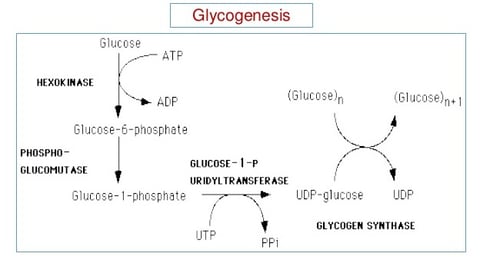GLYCOGENESIS AND GLYCOGENOLYSIS
Discover the intricate processes of glycogenesis and glycogenolysis in human metabolism. Glycogenesis involves the formation of glycogen from glucose, crucial for energy storage in muscles and liver. On the other hand, glycogenolysis is the breakdown of glycogen to release glucose when energy demands rise. Learn about their roles, regulation, and significance in maintaining metabolic balance.
CARBOHYDRATE METABOLISM
GLYCOGENESIS
1. Glycogenesis
• Glycogenesis is the synthesis of glycogen from glucose.
• It occurs mainly in the liver and muscles.Requires ATP and UTP for activation.
2. Synthesis of UDP-Glucose:
• Hexokinase and Glucokinase enzymes convert glucose to glucose-6-phosphate.
• Phosphoglucomutase converts glucose-6-phosphate to glucose-1-phosphate.
• UDP-glucose pyrophosphorylase synthesizes UDP-glucose from glucose-1-phosphate and UTP.
3. Primer Requirement for Initiating Glycogenesis:
• A small fragment of pre-existing glycogen serves as a primer.
• In its absence, glycogenin protein can initiate glycogen synthesis by accepting glucose from UDP-glucose.
• Glycogenin acts as the primer, enabling glycogen synthase to add subsequent glucose molecules.
4. Glycogen Synthesis by Glycogen Synthase:
• Glycogen synthase catalyzes the formation of α-1,4-glycosidic linkages.
• It transfers glucose from UDP-glucose to the non-reducing end of glycogen.
• This process elongates the glycogen chain.
5. Formation of Branches in Glycogen:
• Glycogen synthesis catalyzes the synthesis of a linear unbranched molecule with α-1,4 glycosidic linkages. Glycogen, however, is transformed into a branched structure.
• The formation of branches is facilitated by the action of a branching enzyme, namely glycogen debranching enzyme (also known as amylo-1,6-glucosidase).
• This enzyme transfers a small fragment of glucose residues (usually consisting of about five to eight glucose units) from the non-reducing end of a glycogen chain to another glucose residue, creating a 1,6-linkage.
• This process leads to the formation of a new non-reducing end beside the existing one.
• Overall, glycogen is elongated and branched by the enzymes glycogen synthase (which uses UDP-glucose and ATP to add glucose residues) and glycogen branching enzyme.
Regulation of Glycogenesis and Glycogenolysis:
(a)Glycogenesis (glycogen synthesis) and glycogenolysis (glycogen breakdown) :-
• These are regulated by enzymes such as glycogen synthase and glycogen phosphorylase, respectively. These processes maintain blood glucose levels.
(b)Regulation Mechanisms:
☀Allosteric Regulation:
• Metabolites can allosterically regulate the activities of glycogen synthase and glycogen phosphorylase.
• Glycogen synthesis increases when substrate availability and energy levels are high, while glycogen breakdown is enhanced when glucose concentration and energy levels are low.
☀Hormonal Regulation:
• Hormones regulate glycogen metabolism through covalent modifications (phosphorylation and dephosphorylation) of enzyme proteins.
☀Influence of calcium:
• When muscle contraction, Ca^2 ions are released from to sarcoplasm reticulum.
• Ca^2 binds to calmodulin-calcium modulating protein and directly activate phosphorylase kinase without environment of c-AMP.
• They influence both glycogen synthesis and degradation.
(c)CAMP as a Second Messenger for Hormonal Regulation:-
• CAMP, activated by hormones like epinephrine, norepinephrine, and glucagon, stimulates adenylate cyclase to increase the production of cyclic AMP (cAMP).
• This molecule then activates protein kinase A, which phosphorylates enzymes involved in glycogen metabolism.
(d)Regulation of Glycogen Synthesis by CAMP:
• CAMP regulates glycogen synthesis through phosphorylation of glycogen synthase by a CAMP-dependent protein kinase.
(e)Regulation of Glycogen Degradation by CAMP:
• Hormones such as epinephrine and glucagon promote glycogenolysis by activating phosphorylase kinase via cAMP.
(f)Overall Effect of Hormones on Glycogen Metabolism:
• Increased levels of glucagon enhance glycogen breakdown, while insulin promotes glycogen synthesis.


GLYCOGENOLYSIS
•Glycogenolysis refer to breakdown and store glycogen in liver and muscle cells.
•It's carry out by a set of enzymes in the cytosol.
Glycogen Degradation Steps :
1.Glycogen Phosphorylase:-
• Sequentially cleaves glucose units from non-reducing ends via 1,4-glycosidic bonds.
• Produces glucose-1-phosphate and retains the glucose branch points.
• Requires pyridoxal phosphate as a cofactor.
2.Debranching Enzymes:-
• Functions as a bifunctional enzyme with two activities:
☀Glycosyltransferase:
• Transfers a block of glucose residues to another chain.
☀α-1,6-Glucosidase:
• Hydrolyzes α-1,6 linkages at branch points, releasing a single glucose molecule. The remaining glycogen molecule becomes accessible for further degradation.
3.Glucose Production:-
• Glucose-1-Phosphate: Produced by glycogen phosphorylase and debranching enzyme.
• Formed from glucose-1-phosphate by phosphoglucomutase.
Also generated through additional steps........
4.Role of Glucose-6-Phosphate:-
• Converted from glucose-1-phosphate by phosphoglucomutase.
• Utilized in peripheral tissues for glycogen synthesis or glycolysis.
• Glycogen degradation involves a series of enzymatic steps:
• Glycogen phosphorylase cleaves glycogen into glucose-1-phosphate.
• Debranching enzymes remove branch points, releasing glucose and preparing the glycogen for further degradation.
• Glucose-1-phosphate is converted to glucose-6-phosphate, which can be used for energy production or stored as glycogen.
Engage with Us:
Stay tuned for more captivating insights and News. Visit our Blogs and Follow Us on social media to never miss an update. Together, let's unravel the mysteries of the natural world.
